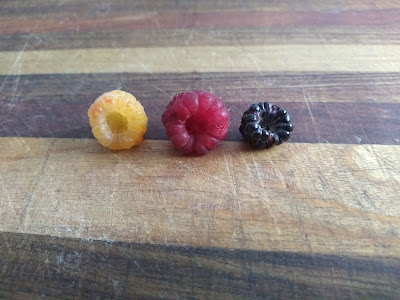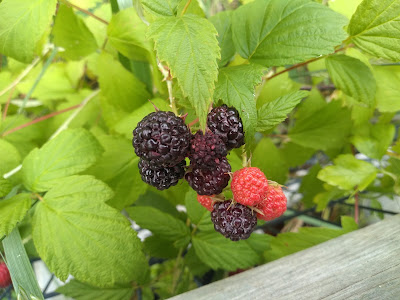I have been growing black raspberries (Rubus occidentalis) for a few years. I think I am one of the few people in Australia who is growing black raspberry plants. These are not blackberries, they are a species of raspberry that produces black fruit. They are a different species to the red raspberry. This species of black raspberry is native to North America where are also called 'black caps'.
I grew my first black raspberry plants from seed in 2019-2020. It took a long time, and was a little tricky, but the resultant plants are great.
I have seen black raspberry seed for sale a few places in Australia, but I would not buy from them as the reviews are either people saying the seed arrived quickly, or that the seed never germinated. Perhaps they didn't germinate as people don't know how to stratify them, or perhaps the seeds are dead, either way I would avoid these companies.
 |
| My back cap raspberries ripening |
My black raspberry plants have strong curved thorns, similar to a rose. They grow long arching canes, and flower on last year's growth. They flower and fruit well, and produce a surprisingly large crop even when not cared for properly.
The berries are smaller than my red or yellow raspberries. My black raspberries also have a lot of seeds. Black raspberries have a distinct taste that everyone seems to enjoy, and many people comment that they are sweeter than yellow raspberries.
I won't go into detail about the differences between black raspberry and red or yellow raspberries here as I wrote an earlier blog post as a comparison of different raspberries.
 |
| Raspberry comparison |
Black raspberry are a different species to a red raspberry. If they cross pollinate it does not change the fruit of your plant. By this I mean a yellow raspberry will produce a yellow fruit no matter what it is pollinated with (and no matter how much Diggers tells you otherwise and tried to blame you for receiving a red fruiting raspberry when you bought 'Diggers Gold' from them). It's only if you plant a seed that is cross pollinated that you will see a difference, and it is the seed grown plant that will show some differences.
I am told when these black raspberries are crossed with red raspberry they produce a purple raspberry. I haven't tasted one of these crosses to know if it is worth making and growing this cross.
I would be curious to cross this with a yellow raspberry, or a thornless raspberry, and see what could be produced. A thornless black raspberry would be great. At this stage I lack the space or the time to try these crosses.
 |
| Black raspberries are productive |
Black raspberry plants don't love to dry out too much, and they do well with some afternoon shade. If they dry out too much I tend to lose some of the berries.
While they probably are susceptible to some diseases, I have never seen any disease touch them. I also don't have problems with pests, and birds don't tend to steal the berries (but this may change).
These plants are surprisingly productive. Even small plants grow large bunches of berries. The berries ripen November/December/January here, some years earlier or later than others, and are always ripe around at Christmas time.As the canes are very thorny, I grow black raspberry plants in pots. That way I can keep them contained and only growing where they can't grab my clothes or pose any risk to my kids. I am sure keeping in pots is limiting their potential.
Under these conditions they grow a meter or two long, I think if they were in soil they could grow larger and be more productive. I don't like thorny plants, and am considering getting rid of them, but they will probably stay as they taste so good.
 |
| Black raspberry fruiting |
Propagating black raspberries is easy enough but takes time. Seed grown can be fiddly but takes a long time, and tip rooting canes is simple but means that cane won't fruit the following year.
Raspberry seeds needs cold wet stratification to germinate. I soak the seeds for a day or so, the water will take on a lot of their colour. I then put the soaked seeds on damp paper in a zip lock bag in the fridge for a minimum of 3 months. This step is not optional, without cold wet stratification black raspberry seeds will not germinate.
The best germination rates I had were cold wet stratified for close to 12 months (because I forgot about them). If cold wet stratifying seeds there is a risk they will germinate in the fridge, so you need to keep an eye on them and plant them if they start to germinate.
After the wet seeds have been in the fridge for a minimum of three months, I plant them in a pot of seed raising mix. This is fiddly as the wet seeds are hard to handle, and they tend to clump together. I water this pot until the seeds germinate, this can be a few days but some will take a few months.
Once germinated, the seedlings are tiny and fragile. If they are crowded they stop growing and will sit at this tiny weak stage with one or two true leaves indefinitely until divided. Dividing tiny seedlings is tricky, I lose a lot whenever I try to do this. Once the seedlings get past this tiny stage they are pretty hardy and grow reasonably fast. Larger pots with more root space translates to much faster growth.
 |
| Black raspberry seed |
I sell black raspberry plants and seeds through my for sale page. I don't have plants available often. Be aware that growing any raspberry from seed is a slow process. They must be cold wet stratified in order to germinate. I stress that stratification is not optional. Putting dry seed in the fridge does nothing, this is not stratification, this would just be long term storage.
The seeds need to be cold and wet for a few months minimum, and seem to do better with longer stratification. Even when you do everything right, sometimes the seeds take a long time to germinate, and some seeds will need to go through a second winter before they germinate.
These black raspberries are a floricane variety, meaning once they have germinated you still have to wait quite a while before you get a crop. After they germinate, they must grow through a warm season, then go through a winter, then the second warm season they will flower on last year's growth. If you have them in poor soil, or with too much competition, you may need to wait an extra year.
Plants are expensive, seeds are cheaper. If you can be bothered to grow them from seed you end up with more plants than you will need.


















































